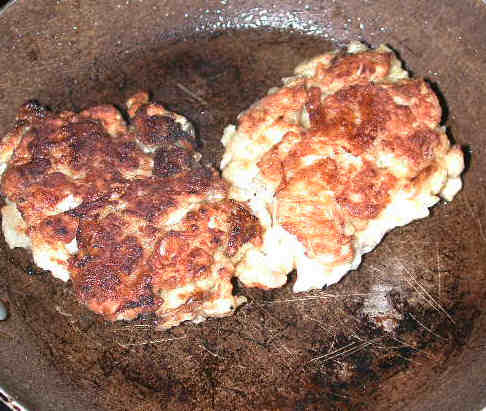| (06-11-02)
#1: Baked Fish
Recently I wanted to cook some fish and decided it would a frozen sheepshead
from the Outer Banks. It would be baked in a skillet, surrounded by pre-cooked
veggies, and a few strips of bacon. The fish probably would have weighed
3 ½ (three and one-half) or four pounds. It had been scaled and
head and entrails had been removed before it was frozen.
After thawing the fish, I scaled it more on cold running water at the
kitchen sink, then allowed it to drain for half an hour. Drying with paper
towel will hasten the drying process.
With tail removed, the fish was a nice fit for my 10-inch iron skillet
which has a cast iron cover.
Here's how:
Coat fish with olive oil and sprinkle liberally (inside and out) with
salt and pepper.
Place pre-cooked (not completely cooked) veggies of your choice around
fish and in the cavity.
Drape fish with two or three strips of bacon (jowl bacon is excellent).
Baked covered for 30 to 45 minutes, or until skin of fish splits, then
broil, to brown, for a few minutes.
Remove fish and veggies from skillet and make a pan of milk gravy for
serving over fish and veggies.
#2:
Leftover Fish Cakes
Save leftover flaky white flesh, pinched into small pieces. Discard
skin and dark colored flesh (this is the circulatory system of the fish.
It offers good fish taste although it is dark or wine-colored).
Refrigerate leftover fish.
When ready to make fish cakes, further pinch fish into smaller pieces.
Add finely-chopped onion, pinched up bread, one egg and enough milk
to saturate the bread. Some flour can be stirred in if needed to thicken
mixture.
Place no-stick skillet on medium-hot burner with 1/8 (one eighth) inch
of olive oil. When skillet is hot enough to sizzle a piece of onion or
bread crumb, spoon mounds of mixture in and flatten them with a spatula
to create cakes. Turn cakes when browned on first side, remove when second
side is browned.
Serve with gravy laced with melted cheese.

|
 |
|
Baked
Fish
|
Fish
Cakes
|
#3: And Now For Some Chowder
OK! So you fudged a little, you didn't use all of the leftover fish
in the fish cakes. You just weren't sure you would like fish cakes. It's
OK!
But let's not waste that leftover, leftover fish. Let's turn it into
yet another great fish dish, and chowder will fill the bill just right.
Making leftover fish chowder is very similar to making fish chowder
from raw (uncooked) fish. The only difference will be noted in the fact
that in making leftover, leftover fish chowder the fish is already cooked
and ready for consumption, which is akin to tickling the palate.
But fish chowder is fish chowder . . . You cook one and you have cooked
the other. The only difference lies in the fact that if you are starting
with raw fish, you simply cook it before you start on the chowder.
Now that we have that straightened out, let's get going with the chowder.
I think in terms of whole, half, and half for my chowder. If I have
two cups of fish (pinched and chopped into small pieces), I think in terms
of one cup of finely chopped potato, and ½ (one-half) cup of finely
chopped onion. Then I go to smaller amounts of mushrooms (wild or store-bought),
carrot, green pepper, or other veggies of your choice, including whole-kernel
corn or green peas.. The veggies, if raw, are pre-cooked (just enough water
to cover them in a saucepan) with a strip of finely chopped bacon.
My formula is designed to thwart attempts of the veggies to take over
my fish chowder. I want the fish taste to dominate my chowder. If I wanted
my chowder to taste like veggies--and sometimes I do--I leave out the fish.
If the fish is raw, cook it right along with the veggies, well seasoned
with salt and pepper.
When the veggies are showing signs of tenderness, drain off the stock
and use it to make a cream sauce by combining it with a few tablespoons
of flour over moderate heat. There will not be enough stock to make a big
cream sauce, but when all of the stock has been used stir in milk, or even
half-and-half.
When the cream sauce cooks to the desired consistency, it should be
stirred into the veggies and the fish. Then the heat should be tuned down
to simmer or a very slow bubble, the pot covered, and the chowder permitted
to steep, sampling it occasionally for taste (C's P), cook's prerogative.
It would be well at this point to point out that chowder should be a
little thicker than soup, but not pasty.
The chowder should be stirred often with a wooden spoon throughout the
cooking and steeping to avoid sticking to the bottom of the pan.
|

